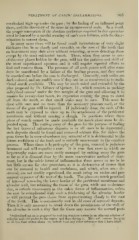Page 955 - My FlipBook
P. 955
TREATMENT OF CALCIC INFLAMMATION. 965 ;
overlooked high up under the gum ; by the finding of an inflamed point
there, and the discovery of its cause in an unremoved scale. In a word,
the proper conception of the absolute perfection required in this operation
nuist be learned by a careful scrutiny of one's own failures, with the deter-
mination to correct them.
In many cases there will be found small incrustations of very slight
thickness that lie so closely and smoothly to the root of the tooth that
an instrument may slide over without removing, or even detecting them
except by the most cultivated touch. These, when they occur in out-
of-the-way places hidden by the gum, will tax the patience and skill of
the most experienced operator, and it will require repeated efforts to
find and remove them. The presence of all such points will after some
days be manifested by a failure of the healing process, and they must
be searched out before the case is discharged. Generally, such scales are
dark-colored, and are readily seen if they can be so uncovered as to make
visual search available. This may be much aided and extended by the
plan proposed by Dr. Gilmer of Quincy, 111., which consists in packing
salicylized cotton^ under the free margin of the gum and allowing it to
remain for twenty-four hours, its expansion causing the gum to stand
off from the tooth, so that small scales may. be seen. This must be
done with care and no more than the necessary pressure used, or the
tissue of the gum wall be injured. If judiciously done, the neck of the
tooth may be exposed to view up to the attachment of the peridental
mend)rane and without causing a slough. In positions where these
plans of search cannot be made available the touch alone must be de-
pended upon. The cutting away of the gum for the purpose of finding
the last traces of calcareous deposits is in all cases to be deprecated
such deposits should be found and removed without this, for unless the
gum tissue be in over-abundance any removal of it is detrimental to the
future usefulness of the teeth and is entirely unnecessary to the curative
process. Where there is hypertrophy of the gum, removal is judicious
treatment and will expedite a cure. It is true that cases in which no
hypertrophy exists are more easily managed by cutting away the gum
as far as it is diseased than by the more conservative method of treat-
ment, but in the calcic forms of inflammation there seems to me to be
but little excuse for this procedure, as it is destructive of tissues that
can be restored to health and usefulness, and which, when one c de-
stroyed, are not readily reprodnced, the result being an undue and per-
manent exposure of the root of the tooth. The plan—so much practised
of late-^of removing the lower border of the peridental membrane and
alveolar wall, but retaining the tissue of the gum, while not so destruc-
tive, is entirely unnecessary in the calcic forms of inflammation, unless
the case be complicated with such a thickening of the alveolar border
as will prevent the gum tissue from approximating closely to the root
of the tooth. This is occasionally seen in old cases of serumal deposits.
Then it is only necessary to break down the prominences of the wall of
the alveolus in such a way that the tissue may assume the normal posi-
^ Salicylized cotton is prepared by soaking common cotton in an ethereal solution of
This will irritate the gum
salicylic acid (40 grains to the ounce) and then drying it.
much less than cotton alone—or, indeed, than any other substance that I have tried.


